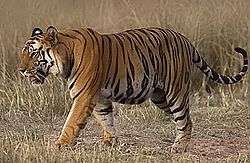Tiger reserves of India
There are 50[1] tiger reserves in India[2] which are governed by Project Tiger which is administered by the National Tiger Conservation Authority (NTCA). India is home to 70 percent of tigers in the world. In 2006, there were 1,411 tigers which increased to 1,706 in 2011 and 2,226 in 2014.[3] According to latest statement by Environment Minister, the count had gone up to 2500 in 2016.
Goals
53,547.5 km2 (20,674.8 sq mi) of declared reserves are operated by state forestry departments "to ensure maintenance of viable populations of the conservation dependent Bengal tigers in India. The tigers are maintained for their scientific, economic, aesthetic, cultural and ecological values and to preserve for all time areas of biological importance as a national heritage for the benefit, education and enjoyment of the people."[4]
Population assessment
By the National Tiger Conservation Authority, estimated only 2,226 adult tigers in existence in India.[5] The 2010 National Tiger Assessment estimated the total population of tigers in India as 1,706. As per Ministry of Environment and Forests, the tiger population in India stood at 2,226 in 2014,[6] with an increase of 30.5% since the 2010 estimate. This exhaustive study indicated that better protected tiger source sites, especially tiger reserves, have maintained viable populations. However, the area occupied by tigers outside protected areas has decreased considerably. This demonstrates the need for corridors for tigers to move between source sites. The existing tiger reserves represent around one-third of India's high density forest area.[7] More tigers were killed in the first quarter of 2016, than in the entire previous year. This significant revelation comes at a time when the tiger census numbers are disputed by the scientific community.
In 2010-11, National Tiger Conservation Authority (NTCA) in partnership with the Wildlife Institute of India (WII) undertook an independent management effectiveness evaluation (MEE) of the 44 tiger reserves in the country. The reserves were categorized into four major categories. Karnataka has the highest number of tigers in the age group of 1.5 years with more 408 big cats. Other states with significant populations included Uttarakhand (340), Madhya Pradesh (308), Tamil Nadu (229), Maharashtra (190), Assam (167), Kerala (136) and Uttar Pradesh (117).[8]
List of Tiger reserves in India
Source:[2]
| S.No. | Tiger Reserve | State | Core Area(km2) | Buffer Area(km2) | Total Area (km2) |
|---|---|---|---|---|---|
| 1 | Bandipur | Karnataka | 872 | 584 | 1,456 |
| 2 | Jim Corbett | Uttarakhand | 822 | 466 | 1,288 |
| 3 | Kanha | Madhya Pradesh | 917 | 1,134 | 2,052 |
| 4 | Manas | Assam | 840 | 2,311 | 3,151 |
| 5 | Melghat | Maharashtra | 1,500 | 1,268 | 2,769 |
| 6 | Palamau | Jharkhand | 414 | 716 | 1,130 |
| 7 | Ranthambore | Rajasthan | 1,113 | 298 | 1,411 |
| 8 | Similipal | Odisha | 1,195 | 1,555 | 2,750 |
| 9 | Sunderbans | West Bengal | 1,700 | 885 | 2,585 |
| 10 | Periyar | Kerala | 881 | 44 | 925 |
| 11 | Sariska | Rajasthan | 881 | 332 | 1,213 |
| 12 | Buxa | West Bengal | 391 | 367 | 758 |
| 13 | Indravati | Chhattisgarh | 1,258 | 1,541 | 2,799 |
| 14 | Namdapha | Arunachal Pradesh | 1,808 | 245 | 2,053 |
| 15 | Dudhwa | Uttar Pradesh | 1,094 | 1,108 | 2,202 |
| 16 | Kalakkad-Mundanthurai | Tamil Nadu | 895 | 707 | 1,602 |
| 17 | Valmiki | Bihar | 598 | 301 | 899 |
| 18 | Pench | Madhya Pradesh | 411 | 768 | 1,180 |
| 19 | Tadoba | Maharashtra | 626 | 1,102 | 1,728 |
| 20 | Bandhavgarh | Madhya Pradesh | 717 | 820 | 1,598 |
| 21 | Panna | Madhya Pradesh | 576 | 1,022 | 1,579 |
| 22 | Dampa | Mizoram | 500 | 488 | 988 |
| 23 | Bhadra | Karnataka | 492 | 572 | 1,064 |
| 24 | Pakhui | Arunachal Pradesh | 683 | 515 | 1,198 |
| 26 | Nameri | Assam | 200 | 144 | 344 |
| 27 | Satpura | Madhya Pradesh | 1,339 | 794 | 2,133 |
| 28 | Anamalai | Tamil Nadu | 959 | 521 | 1,480 |
| 29 | Udanti-Sitanadi | Chhattisgarh | 851 | 991 | 1,843 |
| 30 | Satkosia | Odisha | 524 | 440 | 964 |
| 31 | Kaziranga | Assam | 626 | 548 | 1,174 |
| 32 | Achanakmar | Chhattisgarh | 626 | 288 | 914 |
| 33 | Kali | Karnataka | 815 | 283 | 1,098 |
| 34 | Sanjay-Dubri | Madhya Pradesh | 813 | 862 | 1,675 |
| 35 | Mudumalai | Tamil Nadu | 321 | 368 | 689 |
| 36 | Nagarahole | Karnataka | 643 | 562 | 1,206 |
| 37 | Parambikulam | Kerala | 391 | 253 | 644 |
| 38 | Sahyadri | Maharashtra | 600 | 565 | 1,166 |
| 39 | Biligiriranga | Karnataka | 359 | 216 | 575 |
| 40 | Kawal | Telangana | 893 | 1,126 | 2,019 |
| 41 | Sathyamangalam | Tamil Nadu | 793 | 615 | 1,408 |
| 42 | Mukandra Hills | Rajasthan | 417 | 343 | 760 |
| 43 | Nawegaon-Nagzira | Maharashtra | 654 | 1241 | 1895 |
| 44 | Nagarjunsagar-Srisailam | Andhra Pradesh | 2,596 | 701 | 3,296 |
| 45 | Amrabad | Telangana | 2,166 | 445 | 2,611 |
| 46 | Pilibhit | Uttar Pradesh | 603 | 127 | 730 |
| 47 | Bor | Maharashtra | 138 | 678 | 816 |
| 48 | Rajaji | Uttarakhand | 820 | 256 | 1,075 |
| 49 | Orang | Assam | 79 | 413 | 492 |
| 50 | Kamlang | Arunachal Pradesh | 671 | 112 | 783 |
| Total | 40340.12 | 30686.98 | 71027.10 | ||
Future
In addition to existing reserves, The in-principle approval has been accorded by the National Tiger Conservation Authority for the creation of four new tiger reserves, and the sites are: Ratapani Tiger Reserve (Madhya Pradesh), Sunabeda Tiger Reserve (Odisha), and Guru Ghasidas (Chhattisgarh). Final approval has been accorded to Kudremukh National Park (Karnataka) for declaring as tiger reserves by States. The State Governments have been advised to send proposals for declaring the following areas as tiger reserves: (i) Suhelwa[9] (Uttar Pradesh), (ii) Mhadei Sanctuary (Goa), (iii) Srivilliputhur Grizzled Squirrel Wildlife Sanctuary / Megamalai Wildlife Sanctuary / Varushanadu Valley (Tamil Nadu), (iv) Dibang Wildlife Sanctuary (Arunachal Pradesh) and (v) Cauvery-MM Hills (Karnataka).[10]
Economic Valuation
An economic valuation of six tiger reserves (Corbett, Kanha, Kaziranga, Periyar, Ranthambore, Sundarbans) concluded "that the monetary values of flow benefits emanating from selected tiger reserves range from 8.3 to 17.6 billion annually. In terms of unit area, this translates into 50,000 to 190,000 per hectare per year. In addition, selected tiger reserves protect and conserve stock valued in the range of 22 to 656 billion".[11]
Gallery
 A tiger at Ranthambore Tiger Reserve, Rajasthan
A tiger at Ranthambore Tiger Reserve, Rajasthan A tiger in Bandhavgarh Tiger Reserve, Madhya Pradesh
A tiger in Bandhavgarh Tiger Reserve, Madhya Pradesh Tigress with her two cubs in Kanha Tiger Reserve, Madhya Pradesh
Tigress with her two cubs in Kanha Tiger Reserve, Madhya Pradesh Tigress walking on the gypsy track in Bijrani zone in Jim Corbett Tiger Reserve, Uttarakhand
Tigress walking on the gypsy track in Bijrani zone in Jim Corbett Tiger Reserve, Uttarakhand A tiger in a unique habitat in mangroves at Sundarbans Tiger Reserve, West Bengal
A tiger in a unique habitat in mangroves at Sundarbans Tiger Reserve, West Bengal A tiger at Tadoba Andhari Tiger Reserve, Maharashtra
A tiger at Tadoba Andhari Tiger Reserve, Maharashtra Tiger brothers in wild at peace.
Tiger brothers in wild at peace.
References
- ↑ http://projecttiger.nic.in/content/109_1_ListofTigerReservesCoreBufferAreas.aspx
- 1 2 "Core buffer areas". Government of India. Retrieved 22 January 2016.
- ↑ "India's tiger population sees 30% increase". BBC. 20 January 2015.
- ↑ "Project Tiger" (PDF). Delhi: Government of India. Retrieved 22 January 2016.
- ↑ Wildlife Institute of India, Dehradun (2008). Y.V. Jhala; R. Gopal; Q. Qureshi, eds. Status of the Tigers, Co-predators and Prey in India (PDF). TR 08/001. New Delhi: National Tiger Conservation Authority, Govt. of India. p. 151.
- ↑ "Population Of Big Cats". Retrieved 22 January 2016.
- ↑ "Tiger Estimate in India" (PDF). Public Information Brochure. New Delhi: Ministry of Environment and Forests, GOI. 28 March 2011. p. 9. Retrieved 21 June 2011.
- ↑ "India's tiger population rises". Deccan Chronicle. 15 January 2015.
- ↑ "Suhelwa Sanctuary". UP Tourism. Retrieved 22 January 2016.
- ↑ http://timesofindia.indiatimes.com/home/environment/flora-fauna/In-principle-approval-given-to-4-new-tiger-reserves-Government/articleshow/51211020.cms
- ↑ (PDF) http://www.iifm.ac.in/sites/default/files/Newspdf/IIFM-NTCA-REPORT.compressed-min.pdf. Retrieved 13 August 2016. Missing or empty
|title=(help)
| Wikimedia Commons has media related to Tiger reserves of India. |
